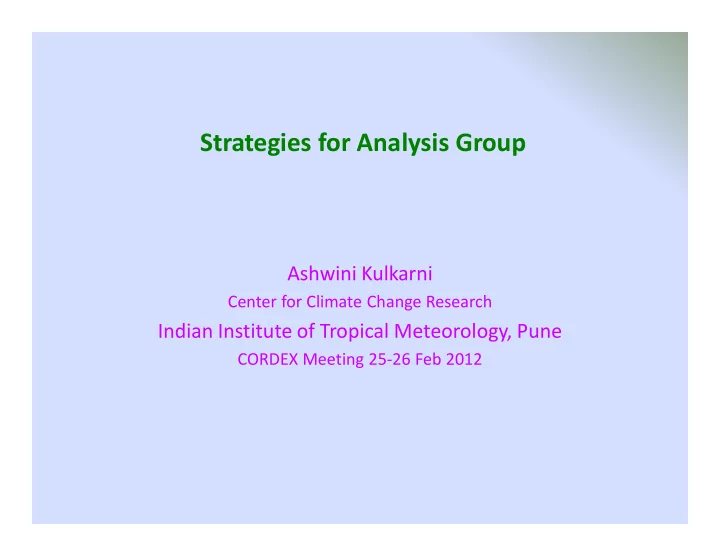

Strategies for Analysis Group Ashwini Kulkarni Center for Climate Change Research Indian Institute of Tropical Meteorology, Pune CORDEX Meeting 25-26 Feb 2012
Major issues are…….. • Parameters to be evaluated • Spatial and temporal resolutions • Observational data sets for validation • Methods for evaluations
The models are reasonably good if • Simulate seasonal cycle • Simulate regional characteristics of precipitation field including major convergence zones, dry/wet regions etc • Simulate typical temporal characteristics of precipitation time series
South Asia (5-35 0 N, 65-95 0 E)
Evaluation Criteria : Precipitation , Temperature • Seasonal Features Annual Cycles Inter-annual Variability � No Long-term Trends � Epochal variability Regional characteristics : Spatial distribution • Intra-seasonal Features Onset Low frequency Oscillations : Strength, coherence, convection and wind variability Northward propagating ISOs form Indian Ocean to 30 o N ~ 30-60 days Westward propagating ISOs from Bay of Bengal to North West India ~ 10-20 days Eastward propagating MJOs along equator Severe Weather Systems Cyclonic Disturbances : Origin, track, pressure, maximum wind speed, landfall • Extremes (Max/Min/percentiles) Amplitude, frequency of daily max / min temperature Frequency, intensity of daily heavy precipitation • ENSO-Snow-Monsoon Tele-connections
Inter-annual Variability of AIMR (1871-2011)
Observed Mean pattern of AIMR (CMAP) The major observed features of the Indian summer monsoon rainfall are: -primary continental rain belt extending from the Bay of Bengal across the Indo-Gangetic plains corresponding to the monsoon trough and the low pressure systems -secondary oceanic rain-belt near the equatorial regions around 5 0 S -west coast rainfall maximum due to the western ghats orographic barrier -maximum rainfall over northeast India associated with the Himalayan orography -low rainfall over northwest India -low rainfall over the southeast peninsula
Observed and model Ensemble mean rainfall during summer monsoon season
Taylor Diagram • Taylor diagram (Taylor 2001) is a graphical summary of how closely a set of patterns matches observations. • The similarity between two patterns is quantified in terms of their correlations, their centered root mean square error and the amplitude of their variations (represented by their standard deviations).
0.0 0 . 1 0.2 OBS 0 A . 3 BCC 0.4 G B CSR CORRELATION 0.5 C GF0 D GF1 0.6 M 1 E GIA Standard Deviation (Normalized) V F GIH 0 . G 7 GIR J H IAP 0.8 0.8 I W IPS E N S J MRI K NCC L NCP 0.6 L H Y 0.9 M U UKG Q K D X N MME I P O BCR R B 0.95 P O 0.4 CCM T Q C CCM2 R CNR S ECH 0.2 T 0 ECO . 9 U INM 9 V MIH W MIM 1.0 0 X UKC 1 0 0.2 0.4 0.6 0.8 Y MME Standard Deviation (Normalized)
ENSEMBLES • Represents new source for studying the range of plausible climate responses to a given forcing Can be generated by • - Collecting results from range of models - generating multiple model versions within particular model structure by varying internal model parameters (perturbed physics ensembles) • Serves to filter out biases of individual models and only retains errors that are generally pervasive. Always in better agreement with observed than individual models
Hence the major requirements are…….. • The models should be able to reproduce main spatial features and tele- connections Models should capture interannual, intra-seasonal and diurnal variability • • Development of regionally specific metric for model evaluation • The methods for quantification and reduction of uncertainties in model simulations
Recommend
More recommend